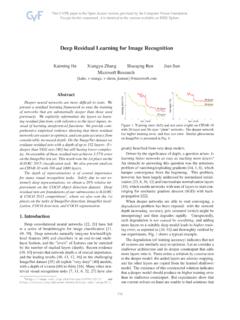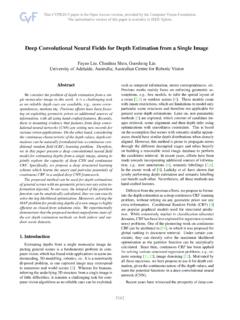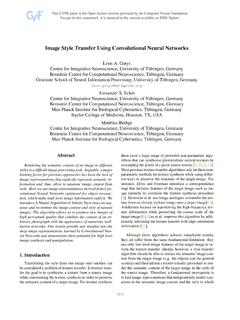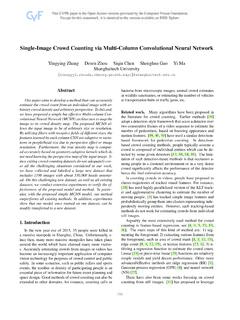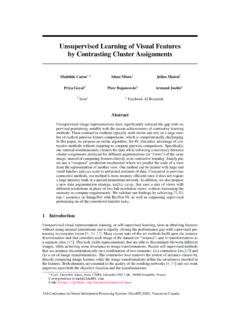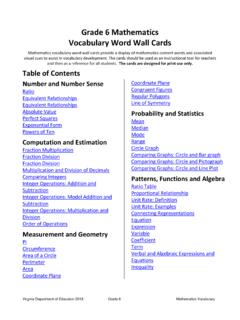Transcription of Hierarchical Convolutional Features for Visual Tracking
1 Hierarchical Convolutional Features for Visual Tracking Chao Ma Jia-Bin Huang Xiaokang Yang Ming-Hsuan Yang SJTU UIUC SJTU UC Merced Abstract around the estimated target location to incrementally learn a classifier over Features extracted from a CNN. Two issues Visual object Tracking is challenging as target objects of- ensue with such approaches. The first issue lies in the use ten undergo significant appearance changes caused by de- of neural networks as an online classifier following recent formation, abrupt motion, background clutter and occlu- object recognition algorithms, where only the outputs of the sion. In this paper, we exploit Features extracted from deep last layer are used to represent targets. For high-level Visual Convolutional neural networks trained on object recognition recognition problems, it is effective to use Features from the datasets to improve Tracking accuracy and robustness.
2 The last layer as they are most closely related to category-level outputs of the last Convolutional layers encode the semantic semantics and most invariant to nuisance variables such as information of targets and such representations are robust intra-class variations and precise location. However, the ob- to significant appearance variations. However, their spatial jective of Visual Tracking is to locate targets precisely rather resolution is too coarse to precisely localize targets. In con- than to infer their semantic classes. Using only the Features trast, earlier Convolutional layers provide more precise lo- from the last layer is thus not the optimal representation for calization but are less invariant to appearance changes. We targets.
3 The second issue is concerned with extracting train- interpret the hierarchies of Convolutional layers as a non- ing samples. Training a robust classifier requires a consider- linear counterpart of an image pyramid representation and ably large number of positive and negative samples, which exploit these multiple levels of abstraction for Visual track- is not available in Visual Tracking . In addition, there lies am- ing. Specifically, we adaptively learn correlation filters on biguity in determining a decision boundary since positive each Convolutional layer to encode the target appearance. and negative samples are highly correlated due to sampling We hierarchically infer the maximum response of each layer near a target. to locate targets. Extensive experimental results on a large- scale benchmark dataset show that the proposed algorithm In this work, we address these two issues by (i) using the performs favorably against state-of-the-art methods.
4 Features from Hierarchical layers of CNNs rather than only the last layer to represent targets; (ii) learning adaptive cor- relation filters on each CNN layer without the need of sam- 1. Introduction pling. Our approach builds on the observation that although the last layers of CNNs are more effective to capture seman- Visual object Tracking is one of the fundamental prob- tics, they are insufficient for capturing fine-grained spatial lems in computer vision with numerous applications [33, details such as object positions. The earlier layers, on the 26]. A typical scenario of Visual Tracking is to track an un- other hand, are precise in localization but do not capture known target object, specified by a bounding box in the first semantics as illustrated in Figure 1.
5 This observation sug- frame. Despite significant progress in the recent decades, gests that reasoning with multiple layers of CNN Features Visual Tracking is still a challenging problem, mainly due for Visual Tracking is of great importance as semantics are to large appearance changes caused by occlusion, deforma- robust to significant appearance variations and spatial de- tion, abrupt motion, illumination variation, and background tails are effective for precise localization. We exploit both clutter. Recently, Features based on Convolutional neural the Hierarchical Features from the recent advances in CNNs networks (CNNs) have demonstrated state-of-the-art results and the inference approach across multiple levels in clas- on a wide range of Visual recognition tasks [20, 11].
6 It is sical computer vision problems. For example, computing thus of great interest to understand how to best exploit the optical flow from the coarse levels of the image pyramid rich feature hierarchies in CNNs for robust Visual Tracking . are efficient, but finer levels are required for obtaining an Existing deep learning based trackers [30, 21, 29, accurate and detailed flow field. A coarse-to-fine search- 18] typically draw positive and negative training samples ing strategy is often adopted for best results [23]. In light 3074. Spatial Details Our Approach Semantics drift. Considerable efforts have been made to alleviate these CNN layers model update problems caused by sample ambiguity. The core idea of these algorithms lie in how to properly update Early layers of CNNs Exploiting both spatial Last layer of CNNs , intensity, Gabor filter details and semantics , fc7 in AlexNet a discriminative classifier to reduce drifts.
7 Examples in- Figure 1. Convolutional layers of a typical CNN model, , clude multiple instance learning (MIL) [1], semi-supervised AlexNet [20], provide multiple levels of abstraction in the fea- learning [10, 12], and P-N learning [19]. Instead of learning ture hierarchies. The Features in the earlier layers retain higher only one single classifier, Zhang et al. [34] combine multi- spatial resolution for precise localization with low-level Visual in- ple classifiers with different learning rates. On the other formation similar to the response map of Gabor filters [4]. On hand, Hare et al. [13] show that the objective of label pre- the other hand, Features in the latter layers capture more seman- diction using a classifier is not explicitly coupled to the ob- tic information and less fine-grained spatial details.
8 Our approach jective of Tracking (accurate position estimation) and pose exploit the semantic information of last layers to handle large ap- Tracking as a joint structured output prediction problem. By pearance changes and alleviate drifting by using Features of earlier alleviating the sampling ambiguity problem, these methods layers for precise localization. perform well in a recent benchmark study [31]. We address the sample ambiguity with correlation filters where training of this connection, we learn one adaptive correlation filter samples are regressed to soft labels of a Gaussian function [3, 16, 7, 35, 6, 17] over Features extracted from each CNN rather than binary labels for discriminative classifier learn- layer and use these multi-level correlation response maps to ing.
9 Collaboratively infer the target location. We consider all the Tracking by Correlation Filters. Correlation filters for shifted versions of Features as training samples and regress Visual Tracking have attracted considerable attention due to them to a Gaussian function with a small spatial bandwidth, its high computational efficiency with the use of fast Fourier thereby alleviating the sampling ambiguity of training a bi- transforms. Tracking methods based on correlation filters nary discriminative classifier. regress all the circular-shifted versions of input Features to a We make the following three contributions. First, we target Gaussian function and thus no hard-thresholded sam- propose to use the rich feature hierarchies of CNNs as tar- ples of target appearance are needed.
10 Bolme et al. [3] learn get representations for Visual Tracking , where both seman- a minimum output sum of squared error filter over lumi- tics and fine-grained details are simultaneously exploited to nance channel for fast Visual Tracking . Several extensions handle large appearance variations and avoid drifting. Sec- have been proposed to considerably improves Tracking ac- ond, we adaptively learn linear correlation filters on each curacy, including kernelized correlation filters [16], multi- CNN layer to alleviate the sampling ambiguity. We infer dimensional Features [17, 7], context learning [35] and scale the target location using the multi-level correlation response estimation [6]. In this work, we propose to learn correlation maps in a coarse-to-fine fashion.
